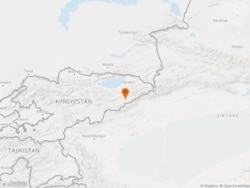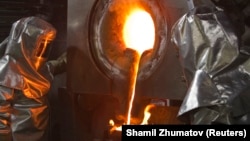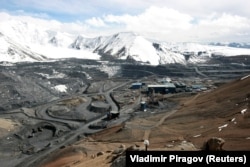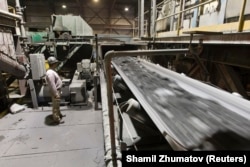Mining the Kumtor gold deposits in the mountains of Kyrgyzstan was supposed to bring economic salvation to the former Soviet republic in Central Asia.
For a country lacking large reserves of oil or natural gas, the government’s joint mining project with a foreign firm was seen as a way to generate revenue from natural resources -- just as most of Kyrgyzstan’s resource-rich neighbors do.
But Bishkek’s partnerships with Canadian firms at the Kumtor gold mine have been contentious since operations began there in 1997.
In recent weeks, the relationship with its current partner -- Centerra Gold -- has deteriorated into a showdown.
Kyrgyz authorities have moved to take far greater control over operations -- arguing the move is temporarily necessary because of environmental damage there.
Centerra has responded by preparing a legal case to fend off the fresh challenges over ownership.
Glaciers near the Kumtor site are at the heart of the environmental concerns.
Above The Lake
The open-pit gold mine is located in mountains towering above the south shore of a massive lake in Kyrgyzstan -- Issyk-Kul.
Extraction work is being done at elevations of 3,600 to 4,000 meters above sea level.
Exploration of the Kumtor deposit was done in the late 1970s when Kyrgyzstan was a Soviet republic.
It was clear there was a large amount of gold there. But Soviet planners deemed it too expensive to develop such a high-elevation gold field in the poorly connected northeastern part of what was then the Soviet republic of Kyrgyzia.
Still, the Soviet Geology Ministry continued the surveying work at the Kumtor deposit, leaving behind detailed records of the riches found there.
When the Soviet Union collapsed in late 1991, several foreign firms showed interest in the site.
Bishkek chose a Canadian company called Cameco and in December 1992, the two parties signed the Kumtor Master Agreement in Toronto.
In 1993, the Kumtor Operating Company was established to run the Kumtor Gold Company (KGC) -- a wholly owned subsidiary of Cameco Gold International.
At the time, gold reserves were estimated to be some 514 tons. Subsequent surveys showed there was more.
It was a great moment for Kyrgyzstan.
Bishkek had a large Western partner to help implement a potentially lucrative project.
While neighboring Kazakhstan, Turkmenistan, and Uzbekistan were waiting for foreign firms to start operations on hydrocarbon fields that required years of preparation, Kyrgyzstan was looking at a relatively quick source of income.
The state gold company Kyrgyzaltyn reported that gold production in the country during 1996 was around 1.5 tons.
In 1997, the year that mining operations began at Kumtor, output increased to about 17 tons.
Kyrgyzstan also cut its trade deficit by more than 60 percent in 1997 and industrial output increased by almost 50 percent. The country’s currency -- the som -- was the most stable currency in the Commonwealth of Independent States (CIS).

Kumtor funded construction of schools and other public facilities. The road linking Bishkek to the mining site was repaired.
The mine itself employed several thousand local workers, as well as work for thousands more across Kyrgyzstan who produced goods and supplies for the venture.
It appeared that the good times were just beginning.
But the global market price of gold decreased dramatically, falling from about $590 per ounce in January 1997 to $477 by the end of the year. Then, in 1998, there was an environmental accident at Kumtor.
A mining truck traveling to the Kumtor site overturned on the mountain road, spilling nearly two tons of sodium cyanide into the small Barskoon River -- the source of water for all the nearby villages in the lower elevations.
Hundreds of villagers became ill. Several died. Thousands needed to be temporarily evacuated.
Making matters worse, the Barskoon River emptied the toxic mining chemicals into Kyrgyzstan’s premier tourist area of Issyk-Kul.
Business on the north shore of the massive lake, more than 50 kilometers across the waters, dropped by more than 50 percent.
A dispute broke out about who was responsible for compensation.
The Kyrgyz government thought Cameco should pay all of it. But Cameco argued that it had only a one-third stake in the project and should only be responsible for one-third of the compensation.
Cameco eventually agreed to a settlement of $4.6 million. Some of that never reached the people affected by the tragedy.
The driver of the truck that overturned was the only person convicted of any crime.
Kyrgyzstan’s parliament voted to revise the contract with Cameco.
By then, there were already questions about how much money Kyrgyzstan was actually receiving from the project.
The Barskoon tragedy raised further questions about how closely Kumtor was following its commitments on environmental protection.
As an open-pit mine, explosives are used at Kumtor to blast out the mountain -- moving down through ice and earth in search of gold.
Waste from blasting was supposed to be trucked away. But with the approval of Kyrgyz authorities, some was simply moved and dumped onto the nearby Davidov and Lysiy glaciers. Over the years, that practice has eroded the glaciers.
In 2003, the Kyrgyz government formed a special commission to revise the contract with Cameco.
By that time, the members of the commission were aware that Cameco was in talks to sell off its Kumtor assets to another Canadian firm -- Centerra Gold.
Cameco had a 33 percent stake in Kumtor. The state-owned Kyrgyzaltyn held all of the remaining 67 percent stake.
In 2004, after the Kyrgyz government commission moved to decrease Kyrgyzstan’s stake in Kumtor to 33 percent, a new agreement was reached.
It allowed Centerra to acquire stakes in the Kumtor mine from both Cameco and Kyrgyzaltyn in exchange for shares in Centerra. The deal left Kyrgyzaltyn with a 33 percent stake in the Kumtor mine.
Cameco divested its remaining Centerra holdings in 2009. The same year, Bishkek reached a new agreement with Centerra. It allowed the Kumtor operation to dump the waste from the mine on the glaciers.
That spawned protests in Bishkek against the environmental damage from mining.
Roads leading to the mine also were sometimes blocked by crowds demanding that Kumtor be nationalized.
Two lawmakers at the time who backed nationalization included Kyrgyzstan’s current president, Sadyr Japarov, and Kamchybek Tashiev, who now heads the State Committee for National Security.
Kyrgyzstan’s share in Kumtor has dwindled to 26 percent.
Some analysts predicted when Japarov was elected president in January that he would move against Kumtor. Now he has.
External Management
On May 7, Kyrgyzstan’s parliament approved a bill to impose temporary external management over Kumtor.
Technically, the bill addresses all organizations with concession agreements in Kyrgyzstan.
But Akylbek Japarov, a lawmaker leading the move against Centerra who has no relation to the president, admitted after the vote that there is only one such enterprise operating in the country.
On May 8, the Oktyabr district court in Bishkek ordered the Kumtor Gold Company to pay about $3.2 million for environmental damage to the Davidov and Lysiy glaciers and for accidents at the site that killed several workers.
That court ruling satisfied the demands of the four activists who filed the complaint in the case: Aibek Sarybaev, Naris Kalchaev, Albas Jeenbenkov, and Kemelbek Kutmanov.
Notably, Kutmanov is the son of the chair of Kyrgyzstan’s State Committee for Ecology and Climate, Dinara Kutmanova.
The Kyrgyz government also claims Kumtor owes $170 million in unpaid taxes.
Centerra says all these claims against the Kumtor mine are without merit.
The Canadian mining firm says it has “initiated binding arbitration against the Government of the Kyrgyz Republic to enforce its rights under longstanding investment agreements with the Government.”
Centerra also says it will "hold the Government accountable in the arbitration for any and all losses and damage that result from its recent actions against KGC and the Kumtor Mine if no resolution is reached."
Analysts say the abrupt moves by the Kyrgyz government stand little chance of holding up in arbitration. But some speculate that the government is simply maneuvering to increase its stake in Kumtor.
Akylbek Japarov was a member of the 2003 commission that moved to reduce Kyrgyzstan’s share holding.
On May 19, he said the Kyrgyz government would demand that its stake be raised to 51 percent of the shares in Centerra.



